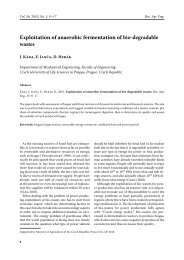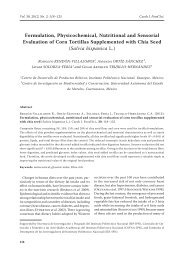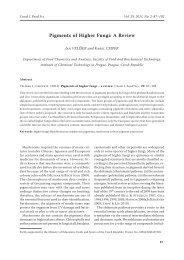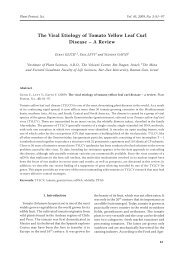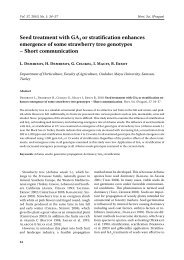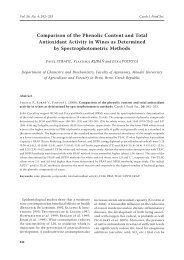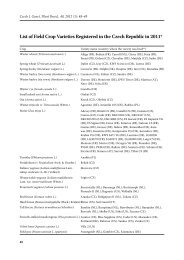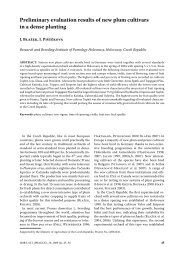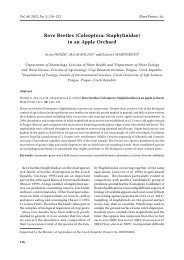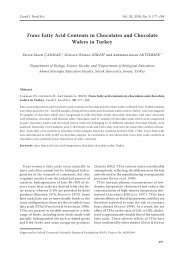Results of dynamic penetration test - Agricultural Journals
Results of dynamic penetration test - Agricultural Journals
Results of dynamic penetration test - Agricultural Journals
You also want an ePaper? Increase the reach of your titles
YUMPU automatically turns print PDFs into web optimized ePapers that Google loves.
<strong>Results</strong> <strong>of</strong> <strong>dynamic</strong> <strong>penetration</strong> <strong>test</strong> – an indicator <strong>of</strong> the<br />
compaction <strong>of</strong> surface soil horizons by forestry machinery<br />
K. Rejšek 1 , J. Buchar 1 , I. Vaníček 2 , L. Hromádko 1 , V. Vranová 1 ,<br />
K. Marosz 1<br />
1 Department <strong>of</strong> Geology and Pedology, Faculty <strong>of</strong> Forestry and Wood Technology,<br />
Mendel University in Brno, Brno, Czech Republic<br />
2 Geotechnical Department, Faculty <strong>of</strong> Civil Engineering, Czech Technical University Prague,<br />
Prague, Czech Republic<br />
ABSTRACT: The objective <strong>of</strong> research was, on the basis <strong>of</strong> the exactly predefined input parameters <strong>of</strong> upper soil horizons<br />
<strong>of</strong> selected forest soils, to perform accurate measurements <strong>of</strong> the impact <strong>of</strong> soil loading by <strong>test</strong>ed forestry machinery<br />
using the <strong>dynamic</strong> <strong>penetration</strong> <strong>test</strong>. The measurements by the <strong>dynamic</strong> <strong>penetration</strong> <strong>test</strong> in conditions changed by the<br />
wheel traffic <strong>of</strong> forestry mechanization were performed at three localities <strong>of</strong> the Křtiny Training Forest Enterprise,<br />
Masaryk Forest, a special-purpose facility <strong>of</strong> Mendel University in Brno. The <strong>dynamic</strong> <strong>penetration</strong> <strong>test</strong> was performed<br />
with a lightweight <strong>dynamic</strong> penetrometer. The methodology <strong>of</strong> the research is based on assessing the ability <strong>of</strong> soils<br />
to resist <strong>dynamic</strong> <strong>penetration</strong> <strong>of</strong> a rod with a cone, in relation to their lithological composition and physicomechanical<br />
properties; the measurement itself is defined by the ISO 22476-2 (2005) standard. Penetrometer measurements<br />
were repeated in the period after a harvesting operation and again 6 months later, i.e. in October 2007, April 2008<br />
and October 2008. The results <strong>of</strong> the field <strong>dynamic</strong> <strong>penetration</strong> <strong>test</strong> and the results <strong>of</strong> laboratory <strong>test</strong>ing <strong>of</strong> main soil<br />
physical parameters are presented in figures and tables. Besides the naturally variable soil compaction on geologically<br />
different substrates, the obtained original results document differences in the impact <strong>of</strong> particular forestry machines.<br />
In conditions <strong>of</strong> the identical geological substrate, the results indicate that the universal wheeled tractor had a more<br />
negative influence on the compaction <strong>of</strong> surface soil horizons compared to the multi-axle harvester and the forwarder.<br />
Keywords: <strong>dynamic</strong> <strong>penetration</strong> <strong>test</strong>; soil compaction; soil mechanics; lightweight <strong>dynamic</strong> penetrometer<br />
The <strong>dynamic</strong> <strong>penetration</strong> method is one <strong>of</strong> the<br />
oldest geotechnical research methods (Matys et<br />
al. 1990), which was used to determine the bearing<br />
capacity <strong>of</strong> subsoil: it was first described in the work<br />
Comprehensive Guidelines to the Art <strong>of</strong> Building<br />
(Vollständige Anweisung zu der Civil Bau-Kunst)<br />
by Nicolaus Goldmann in 1699 as a method <strong>of</strong><br />
driving a coned rod into soil with a hammer. Before<br />
World War II, A. Kumm developed a <strong>dynamic</strong><br />
<strong>penetration</strong> <strong>test</strong> with the <strong>dynamic</strong> part <strong>of</strong> the<br />
penetrometer having the constant weight <strong>of</strong> 5–8 kg<br />
and the fall height <strong>of</strong> 50 cm; the <strong>test</strong>ing rod was<br />
15 mm in diameter, with a pyramid-shaped end.<br />
JOURNAL OF FOREST SCIENCE, 57, 2011 (10): 439–450<br />
In the 1950s, devices allowing the <strong>penetration</strong> <strong>of</strong> a<br />
sampling cylinder were designed. Unification <strong>of</strong> the<br />
<strong>dynamic</strong> <strong>penetration</strong> <strong>test</strong> in European countries<br />
was facilitated by the German standard DIN 4094<br />
in 1977.<br />
The specific aim <strong>of</strong> the performed investigation<br />
was to assess the applicability <strong>of</strong> the <strong>dynamic</strong> <strong>penetration</strong><br />
<strong>test</strong> as a method for the study <strong>of</strong> compaction<br />
<strong>of</strong> the upper forest soil horizons. The basic<br />
theoretical source is a key comparative study <strong>of</strong><br />
Marshall et al. (2001). The present state <strong>of</strong> the art<br />
in the field <strong>of</strong> soil compaction was taken over partly<br />
from the work <strong>of</strong> Lebert et al. (2007), partly from<br />
Partly supported by the Ministry <strong>of</strong> Agriculture <strong>of</strong> the Czech Republic, Project No. QH71159.<br />
J. FOR. SCI., 57, 2011 (10): 439–450 439
Cetin et al. (2007). Significant issues regarding a<br />
broader environmental perception <strong>of</strong> the problem<br />
<strong>of</strong> soil surface compaction were presented by the<br />
authors on the basis <strong>of</strong> discussion papers <strong>of</strong> Tullberg<br />
(2001) and Kirby (2007). As a material for<br />
comparison from the historical point <strong>of</strong> view, the<br />
authors chose the PhD thesis <strong>of</strong> Etana (1995). The<br />
state <strong>of</strong> the art in the field <strong>of</strong> application <strong>of</strong> the <strong>dynamic</strong><br />
<strong>penetration</strong> method with emphasis on the<br />
lightweight <strong>penetration</strong> set was described in the review<br />
<strong>of</strong> literature and the following discussion <strong>of</strong> the<br />
own results represented by Vaníček and Vaníček<br />
(2008) and normative material ISO 22476-2 (2005),<br />
based on the German standard DIN 4094 (Matys<br />
1990).<br />
To discuss the currently used low-impact hauling<br />
technologies in Czech forestry (Report on the<br />
State <strong>of</strong> Forests and Forestry in the Czech Republic<br />
by 2009/2010), the authors <strong>of</strong> this chapter used<br />
the findings <strong>of</strong> Malík and Dvořák (2007), Oliva<br />
(2008), Vavříček et al. (2008), and Klvač et al.<br />
(2010).<br />
As regards the measuring itself, it is necessary<br />
to say that the penetrometer is an appliance able<br />
to examine and eventually also to record the individual<br />
layers <strong>of</strong> subsoil. It works on the principle <strong>of</strong><br />
a steel cone that is driven into the soil which resists<br />
the <strong>penetration</strong>. As each soil unit is characterized<br />
by different resistance due to variability <strong>of</strong> physical,<br />
hydrophysical and soil-mechanical properties <strong>of</strong> the<br />
upper soil horizons, the use <strong>of</strong> this appliance allows<br />
to assess the thickness as well as compaction <strong>of</strong> the<br />
upper soil horizons through mathematico-physical<br />
relations (Vaníček, Vaníček 2008). The measurements<br />
were performed with <strong>dynamic</strong> penetrometer.<br />
The principle <strong>of</strong> its function is that the falling component<br />
(<strong>dynamic</strong> part <strong>of</strong> the penetrometer) passes<br />
an exact amount <strong>of</strong> kinetic energy to the solid part<br />
(static part <strong>of</strong> the penetrometer, linkage with a<br />
cone), which then vertically penetrates into the soil<br />
pr<strong>of</strong>ile. The measured data are standardly obtained<br />
by counting the number <strong>of</strong> hits necessary to reach a<br />
specified depth (standard depth unit). The authors<br />
<strong>of</strong> this paper used a modification “depth per hit”,<br />
with the aim to obtain more precise information on<br />
compaction in smaller depth intervals than can be<br />
provided by the standard method. The evaluation<br />
graphs had to be adapted to this modification (the<br />
authors <strong>of</strong> the chapter did not consider the average<br />
number <strong>of</strong> hits for cone <strong>penetration</strong> by 20 cm<br />
– usually the average number <strong>of</strong> hits is calculated<br />
and taken as 100%). The construction <strong>of</strong> <strong>dynamic</strong><br />
penetrometers is based on the application <strong>of</strong> the<br />
standard ISO 22476-2 (2005) for differentiation <strong>of</strong><br />
<strong>dynamic</strong> penetrometer light DPL (<strong>dynamic</strong> part <strong>of</strong><br />
the penetrometer up to 10 kg; fall height 0.5 m), <strong>dynamic</strong><br />
penetrometer medium DPM (<strong>dynamic</strong> part<br />
<strong>of</strong> the penetrometer up to 30 kg; fall height 0.5 m),<br />
<strong>dynamic</strong> penetrometer heavy DPH (<strong>dynamic</strong> part<br />
<strong>of</strong> the penetrometer up to 50 kg; fall height 0.5 m)<br />
and <strong>dynamic</strong> penetrometer super-heavy DPSH<br />
(<strong>dynamic</strong> part <strong>of</strong> the penetrometer up to 63.5 kg;<br />
fall height 0.5 m–0.75 m). Lightweight portable <strong>dynamic</strong><br />
penetrometer is made either with automatic<br />
drive, hydraulic drive or with manual drive. The<br />
record is taken either manually (aimed at registration<br />
<strong>of</strong> depths), by means <strong>of</strong> laser beam or by ultrasound,<br />
with editing directly into a data logger.<br />
As regards the significance <strong>of</strong> such measurement,<br />
we can say that in contrast to agriculture, the field<br />
<strong>of</strong> forestry has fulfilled production and social roles<br />
<strong>of</strong> forests over decades with a strong (for central-<br />
European conditions) emphasis on ensuring the<br />
ecological stability <strong>of</strong> forest stands (Míchal 1992)<br />
in the conditions <strong>of</strong> variable effectiveness <strong>of</strong> external<br />
factors affecting the long-term ability <strong>of</strong> forest<br />
ecosystems to maintain their parameters by<br />
internal self-regulated mechanisms (resistance)<br />
or to restore the original state after disturbance<br />
(resiliency). Soil is the basic abiotic component <strong>of</strong><br />
terrestrial ecosystems (Rejšek et al. 2009): especially<br />
with regard to a potentially negative impact<br />
<strong>of</strong> forestry machinery traffic on the persistence <strong>of</strong><br />
production conditions, the problem <strong>of</strong> soil productivity<br />
maintenance becomes a subject <strong>of</strong> increased<br />
interest among forestry pr<strong>of</strong>essionals. The introduction<br />
<strong>of</strong> mechanization machines into harvesting<br />
operations took a longer time in Czech forestry;<br />
by the 1980’s, mechanization consisted mainly <strong>of</strong><br />
log hauling equipment that used previously constructed<br />
forest roads and therefore it did not cause<br />
any significant damage to forest soil. Only in connection<br />
with the development <strong>of</strong> harvester technologies,<br />
forestry machines started to be employed<br />
in all phases <strong>of</strong> forest production and thus they operate<br />
on an ever increasing part <strong>of</strong> soil assigned to<br />
fulfil the roles <strong>of</strong> the forest (Law on Forest 1995).<br />
Besides, the impact <strong>of</strong> hauling equipment itself,<br />
in connection with advancement <strong>of</strong> its functions<br />
linked to changes <strong>of</strong> its technical parameters –<br />
mainly <strong>of</strong> total weight, speed <strong>of</strong> travel, number <strong>of</strong><br />
axles, and the use <strong>of</strong> tracked or tracked-wheel technology<br />
– has been gaining significance over the last<br />
thirty years, also in relation to the network <strong>of</strong> hauling<br />
roads and potential emergence <strong>of</strong> erosion rills<br />
in crowns <strong>of</strong> these roads (Malík, Dvořák 2007).<br />
It is clear that specific hauling machines <strong>of</strong> different<br />
adhesion weight and different tractive efficien-<br />
440 J. FOR. SCI., 57, 2011 (10): 439–450
cy provoke pressures in the soil that spread to sides<br />
and to depth and have different impacts on the<br />
soil body impairment in different soil units (especially<br />
clay vs. sandy soils and waterlogged vs. nonwaterlogged<br />
sites), in different types <strong>of</strong> forest sites<br />
(especially flat terrain vs. slope and terrain with<br />
obstacles vs. terrain without obstacles) – under different<br />
impacts <strong>of</strong> actual meteorological conditions<br />
in the conditions <strong>of</strong> locally specific mesoclimate <strong>of</strong><br />
the forest stands in questions, when it is mainly the<br />
high soil water content that determines reversible<br />
vs. irreversible compaction <strong>of</strong> upper soil horizons.<br />
An example <strong>of</strong> considering the potential impact<br />
<strong>of</strong> hauling equipment on forest soil is the Ecowood<br />
partnership classification (Owende et al. 2002),<br />
ranking forest soils into the following four categories<br />
according to their bearing capacity: solid soils,<br />
average bearing soils, s<strong>of</strong>t soils and very s<strong>of</strong>t soils.<br />
The criterion <strong>of</strong> this classification is the magnitude<br />
<strong>of</strong> pressure not generating measurable damage: solid<br />
soils are not damaged even at the pressure <strong>of</strong> 80<br />
kPa, average bearing soils maintain the same state<br />
<strong>of</strong> soil environment at pressures between 60 kPa<br />
and 80 kPa, s<strong>of</strong>t soils between 40 and 60 kPa; very<br />
s<strong>of</strong>t soils are damaged even by simple walking (the<br />
foot <strong>of</strong> an adult exerts the pressure <strong>of</strong> about 40 kPa<br />
on soil). However, the presented categorization is<br />
much more complex from the viewpoint <strong>of</strong> forestry<br />
as besides the soil compression due to machine<br />
traffic and subsequent origination <strong>of</strong> a rut, it is necessary<br />
to consider the chassis properties <strong>of</strong> a moving<br />
machine, so called slipping, and also the pressure<br />
spreading on a base <strong>of</strong> the travel medium in<br />
direct relation to the resistance <strong>of</strong> the base during<br />
the traffic <strong>of</strong> the studied forestry machinery. From<br />
the aspect <strong>of</strong> soil science, two parameters are <strong>of</strong> key<br />
importance – grain size and water content <strong>of</strong> the<br />
upper soil horizons.<br />
From the forestry point <strong>of</strong> view, it is possible to<br />
look at the negative impact <strong>of</strong> hauling machinery<br />
on forest soil from three aspects: mechanical damage<br />
to roots <strong>of</strong> forest woody species, compaction <strong>of</strong><br />
upper soil horizons and increase in the mechanical<br />
resistance <strong>of</strong> soil to root growth. Nevertheless, the<br />
study <strong>of</strong> soil mechanics provides information that<br />
can be used for assessment <strong>of</strong> the process <strong>of</strong> compaction<br />
as well as for determination <strong>of</strong> a decrease in<br />
the availability <strong>of</strong> particular nutrients, oxygen and<br />
water, and, on the other hand, <strong>of</strong> an increase in the<br />
carbon dioxide concentration in soil caused by the<br />
reduced rate <strong>of</strong> CO 2 output (produced by respiration<br />
<strong>of</strong> soil biota and plant roots, mineralization <strong>of</strong><br />
organic matter and decomposition <strong>of</strong> carbonates)<br />
from forest soil.<br />
It is clear that for the above-mentioned goal it<br />
was necessary to start from determination <strong>of</strong> critical<br />
values <strong>of</strong> particular factors. The limiting values<br />
are such values that cause a disturbance <strong>of</strong> soil regimes<br />
and functions if they are exceeded – specifically,<br />
Lhotský (2000) considered the following parameters<br />
to be critical for forest soils:<br />
– bulk density: 1.3–1.7 g·cm –3 ; it depends on the<br />
particle size distribution <strong>of</strong> a particular horizon,<br />
– minimum air capacity/aeration: 10–12%,<br />
– relative capillary water content (by volume): 80%,<br />
– bulk density limiting the root growth: 1.5 to<br />
1.7 g·cm –3 ,<br />
– content <strong>of</strong> silt particles (0.01–0.05 mm): 20%.<br />
Therefore, the impact <strong>of</strong> hauling technology on<br />
physical, hydrophysical and soil-mechanical properties<br />
is directly linked to water content in topsoil<br />
and to water contents (by both mass and volume)<br />
<strong>of</strong> surface horizons, as well as to the pressure generated<br />
by the traffic <strong>of</strong> specific forestry equipment;<br />
these factors then determine the influences <strong>of</strong> distribution<br />
<strong>of</strong> this pressure in soil to the contact areas<br />
<strong>of</strong> secondary structural elements – soil aggregates.<br />
Neruda et al. (2008) explicitly stated that the pressure<br />
<strong>of</strong> 0.15 MPa affected the soil environment to<br />
the depth <strong>of</strong> approximately 0.35–0.40 m and that<br />
the more yielding and wetter the soil, the greater<br />
the depth <strong>of</strong> pressure effect. The same authors just<br />
as explicitly set the depth <strong>of</strong> the ruts generated by<br />
forestry machinery traffic to the limit <strong>of</strong> 10 cm,<br />
which is regarded as acceptable soil damage. Besides,<br />
the impact <strong>of</strong> hauling technology on physical,<br />
hydrophysical and soil-mechanical properties<br />
is also conditioned by so called technological properties<br />
<strong>of</strong> soil – soil consistency and its components,<br />
soil elasticity and plasticity. Here a rule is applicable<br />
that the upper soil horizons with high elasticity<br />
tend to restore their original level <strong>of</strong> physical,<br />
hydrophysical and soil-mechanical properties after<br />
being disturbed by forestry mechanization traffic,<br />
while the upper horizons with high plasticity are<br />
irreversibly compacted. The process <strong>of</strong> compaction<br />
proceeds in two phases, i. e. in the first versus repeated<br />
passes: the first pass causes predominantly<br />
the plastic (permanent) deformation, in the second<br />
phase (repeated passes) mainly the elastic deformation<br />
occurs as the load affects soil horizons with<br />
previously changed properties (Lhotský 2000).<br />
In this context it is necessary to stress the role <strong>of</strong><br />
root systems <strong>of</strong> forest woody species (Ulrich et al.<br />
2003): where the upper soil horizons are reinforced<br />
with root systems <strong>of</strong> undergrowth, the elasticity <strong>of</strong><br />
the specific horizons is increased and irreversible<br />
damage after one pass is minimized. However, in<br />
J. FOR. SCI., 57, 2011 (10): 439–450 441
the case <strong>of</strong> repeated passes, permanent damage is<br />
rightly expectable: Ulrich et al. (2003) reported<br />
the grea<strong>test</strong> soil compaction to occur with the first<br />
to the third pass, but after the fifth to the tenth pass<br />
the compaction consolidates to such an extent that<br />
a further increase <strong>of</strong> bulk density is minimal.<br />
Forestry mechanization traffic affects the forest<br />
soil both directly and indirectly, having a fundamental<br />
impact on its physical, hydrophysical<br />
and soil-mechanical properties. These properties<br />
are inherent in the soil structure; that, in return,<br />
has a key role in the air and water regime <strong>of</strong> forest<br />
soils and hence also in their production capacity<br />
(Rejšek 2003). The influence <strong>of</strong> hauling technology<br />
on the soil structure can be quantified quite specifically<br />
as shown in Table 1. It is a very significant<br />
characteristic from the aspect <strong>of</strong> forestry (especially<br />
with respect to the fulfilment <strong>of</strong> social roles <strong>of</strong><br />
forest): after multiple mechanical disturbance <strong>of</strong> its<br />
structure, the soil becomes permanently unstructured,<br />
losing the ability to regenerate (Kutílek et<br />
al. 2000), which makes the danger <strong>of</strong> soil structure<br />
damage even more serious. Its seriousness is evident<br />
from the fact that the root space serves for an<br />
exchange <strong>of</strong> ions, movement <strong>of</strong> water and exchange<br />
<strong>of</strong> gases. Therefore, the traffic <strong>of</strong> forestry mechanization<br />
changes water and air regimes <strong>of</strong> soil by<br />
causing defects in the soil structure (Table 1).<br />
Lhotský (2000) explicitly characterized the negative<br />
influences as follows:<br />
‒ deficit <strong>of</strong> oxygen for plant roots induces an overall<br />
stress to plants – as a result, the lack <strong>of</strong> oxygen<br />
further worsens, aerobic processes are restricted<br />
or blocked and anaerobic processes develop with<br />
all the consequences <strong>of</strong> development <strong>of</strong> poor humus,<br />
unfavourable intermediate products and<br />
soil acidification;<br />
– in soils with disturbed structure, metabolic processes<br />
are reduced and the energy becomes less accessible<br />
to plants;<br />
– soil partially loses the ability to respond to<br />
harmful substances, which lowers its sanitary<br />
effectiveness;<br />
– with acidification, the uptake <strong>of</strong> nutrients by<br />
plants is failing and the mobility <strong>of</strong> most <strong>of</strong> the<br />
potentially harmful elements increases as they are<br />
conversely taken more intensively by plants;<br />
– destruction <strong>of</strong> soil structure contributes to reduced<br />
infiltration, increasing the risk <strong>of</strong> erosion<br />
occurrence and local accumulation <strong>of</strong> erosive<br />
wash material including risky substances;<br />
– in loamy and clayey soils, the destructed structure<br />
may cause defects in growth and quality <strong>of</strong><br />
plants, especially in extreme climatic situations<br />
(waterlogging, drought);<br />
– in lighter granular soils, damage to their structure<br />
speeds up mineralization with production <strong>of</strong> nitrates,<br />
which are taken up by plants or washed out<br />
into groundwater to a greater extent.<br />
Quite specifically, the impact <strong>of</strong> hauling technology<br />
on physical, hydrophysical and soil-mechanical<br />
properties can be quantified by Table 2.<br />
Neither the study <strong>of</strong> compaction <strong>of</strong> the upper forest<br />
soil horizons nor the study <strong>of</strong> impacts <strong>of</strong> hauling<br />
technology on soil water movement is based on<br />
internationally recognized evaluation methods. In<br />
forestry literature we can find different approaches<br />
to the above-mentioned problems – they are evaluated<br />
by visual estimation, simple measurements <strong>of</strong><br />
rut depth, as well as by complex methods using soil<br />
pressure probes. Dynamic <strong>penetration</strong> <strong>test</strong> (Herrick,<br />
Jones 2002) cannot measure instantaneous<br />
pressures on a measurement unit, however, its application<br />
in compaction evaluation allowed Neruda<br />
(2008) to express the following statements that<br />
are connected with requirements <strong>of</strong> forestry practice<br />
for its interaction with forestry research:<br />
(1) after the first pass, maximum compaction is not<br />
detected, which is due to the soil horizon elasticity;<br />
(2) a positive effect <strong>of</strong> brash (logging residues) covering<br />
the forest floor in places <strong>of</strong> forestry machinery<br />
movement has been confirmed;<br />
(3) higher pressures produced by forestry mechanization<br />
traffic were measured on forest soils with<br />
dried-out surface, the highest values <strong>of</strong> pressure being<br />
reached during passes over small terrain irregularities<br />
due to the combination <strong>of</strong> machinery traction<br />
power and <strong>dynamic</strong> effects <strong>of</strong> their movement.<br />
As mentioned above, the aim <strong>of</strong> the present study<br />
can be seen in the application <strong>of</strong> <strong>dynamic</strong> penetra-<br />
Table 1. The critical values <strong>of</strong> bulk density and porosity at the moment when the compaction <strong>of</strong> surface soil horizons<br />
occurs according to Šimon and Lhotský (1989)<br />
Soil textural classes Clay<br />
Sandy clay,<br />
silty clay<br />
442 J. FOR. SCI., 57, 2011 (10): 439–450<br />
Loam<br />
Sandy loam,<br />
sandy silt loam<br />
Loamy sand Sand<br />
Bulk density (g·cm –3 ) > 1.35 > 1.40 > 1.45 > 1.55 > 1.60 > 1.70<br />
Porosity (%) < 48 < 47 < 45 < 42 < 40 < 38
Table 2. The critical values <strong>of</strong> bulk density in its natural<br />
condition (g·cm –3 ) in the first moment <strong>of</strong> plant root growth<br />
restriction according to Arshad and Coen (1992)<br />
Soil textural classes<br />
Minimum value <strong>of</strong> bulk<br />
density for the first moment <strong>of</strong><br />
plant root growth restriction<br />
Sand, loamy sand 1.80<br />
Sandy loam, sandy silt loam 1.75<br />
Loam, sandy clay loam 1.70<br />
Sandy clay, silty clay 1.65<br />
Sandy clay 1.55<br />
Silty clay 1.45<br />
Clay 1.40<br />
tion <strong>test</strong> as a method for the study <strong>of</strong> compaction<br />
<strong>of</strong> the upper forest soil horizons. The investigation<br />
focused on the assessment <strong>of</strong> impacts <strong>of</strong> selected<br />
forestry hauling technology on selected localities<br />
<strong>of</strong> the Křtiny Training Forest Enterprise, Masaryk<br />
Forest, with special attention paid to <strong>dynamic</strong> <strong>penetration</strong><br />
<strong>test</strong> as a method for the inspection <strong>of</strong> soil<br />
pr<strong>of</strong>ile compaction in forestry. The stands and the<br />
intensity <strong>of</strong> forestry measures were chosen on the<br />
basis <strong>of</strong> similar parameters with regard to later interpretation<br />
<strong>of</strong> results that would also allow a comparison<br />
<strong>of</strong> changes in the characteristics between<br />
particular localities.<br />
MATERIAL AND METHODS<br />
As regards forestry mechanization, we used a<br />
universal wheeled tractor Zetor 7245 Horal System<br />
with the four-wheel drive (4 × 4) and standard tyres<br />
Mitas 11.2–24'' pr<strong>of</strong>ile TD-19, on the front axle, and<br />
tyres 16.9–30'', pr<strong>of</strong>ile TD-13, on the rear axle. Simultaneously,<br />
we <strong>test</strong>ed a three-axle 16 t harvester<br />
PONSSE ERGO 16 and a four-axle forwarder Gremo<br />
950 with the service weight <strong>of</strong> nearly 12 t. The<br />
forwarder was equipped with Nokian tyres <strong>of</strong> 700 ×<br />
22.5" on all axles. All wheels <strong>of</strong> the forwarder were<br />
fitted with non-skid chains. For the performed field<br />
surveys, we used a lightweight <strong>dynamic</strong> penetrometer<br />
<strong>of</strong> the total weight 71 kg and with the following<br />
components/parameters:<br />
– drop rammer with handles – 10 kg,<br />
– impact anvil with a reading needle,<br />
– sounding rod, ø 22 mm, length 1 m, threaded<br />
collar M 16,<br />
– guiding rod, base plate, extracting extension<br />
with a lever, steel gauge <strong>of</strong> 1 m, hammering head<br />
with handles, grooved rod <strong>of</strong> 1 m – thread M 16,<br />
joining screws M 16 × 40 INBUS,<br />
– small drive point – 90°, 5 cm 2 , ø 24.2 mm,<br />
– large drive point – 90°, 10 cm 2 , ø 35.6 mm.<br />
The survey was carried out on three study plots<br />
within the Křtiny Training Forest Enterprise, Masa-<br />
ryk Forest, a special-purpose facility <strong>of</strong> Mendel University<br />
in Brno. All study plots are situated in a<br />
special-purpose forest with high forest silvicultural<br />
system and shelterwood (small-area felling) or clearcutting<br />
system <strong>of</strong> management. Generally we can say<br />
that the study plot in Babice nad Svitavou represented<br />
the group <strong>of</strong> forest types 3 A, i.e. lime-oak beech<br />
forest, and according to the framework management<br />
guidelines it represented management set <strong>of</strong> stands<br />
306 Special-purpose beech management <strong>of</strong> drying<br />
and drier aceros and basic sites at medium altitudes.<br />
In Rudice, the study plots belonged to the group <strong>of</strong><br />
forest types 4K, i.e. acidic beech stands, management<br />
set <strong>of</strong> stands 421 Special-purpose spruce management<br />
<strong>of</strong> acidic sites at medium altitudes.<br />
Measurements by the <strong>dynamic</strong> <strong>penetration</strong> <strong>test</strong><br />
as the level <strong>of</strong> compaction <strong>of</strong> the upper horizons<br />
in forest soils in conditions changed by the traffic<br />
<strong>of</strong> forestry mechanization were performed at three<br />
localities <strong>of</strong> the Křtiny Training Forest Enterprise,<br />
Masaryk Forest. Soil pr<strong>of</strong>iles were open and described<br />
there. Simultaneously field measurements<br />
<strong>of</strong> <strong>penetration</strong> with the lightweight <strong>dynamic</strong> penetrometer<br />
were also carried out, based on assessing<br />
the ability <strong>of</strong> soils to resist <strong>dynamic</strong> <strong>penetration</strong> <strong>of</strong> a<br />
rod with a cone, in relation to their lithological composition<br />
and physicomechanical properties; the<br />
measurement itself is defined by the ISO 22476-2<br />
(2005) standard. Penetrometer measurements were<br />
repeated in the period after a harvesting operation<br />
and again 6 months later, i.e. in October 2007, April<br />
2008 and October 2008.<br />
<strong>Results</strong> from study plot No. 2 were obtained in a<br />
skidding trail with the total <strong>of</strong> 5 passes <strong>of</strong> the universal<br />
wheeled tractor Zetor 7245 Horal that had<br />
transported 12 m 3 <strong>of</strong> timber in semi-suspension.<br />
Control measurements were performed 15 m from<br />
the <strong>test</strong>ing trail in a young stand unaffected by the<br />
described tractor operation. At this locality, 20 <strong>penetration</strong><br />
<strong>test</strong>s were carried out in total, resulting<br />
in 18 representative transects, as in two cases the<br />
measurement was distorted by a stone and had to<br />
be excluded from the evaluation. <strong>Results</strong> from study<br />
plot No. 3 reflect the situation after mechanized<br />
thinning with a PONSSE ERGO 16 harvester and<br />
the following haulage with a Gremo 950 forwarder.<br />
Within the operation, 560 m 3 <strong>of</strong> timber were harvested,<br />
both roundwood assortments and pulpwood.<br />
J. FOR. SCI., 57, 2011 (10): 439–450 443
<strong>Results</strong> from study plot No. 4 document motomanual<br />
thinning followed by extraction and skidding works<br />
with the universal wheeled tractor Zetor 7245 Horal;<br />
16.4 m 3 <strong>of</strong> timber were harvested in total.<br />
The nomenclature <strong>of</strong> the forest soil units is given<br />
in IUSS Working Group WRB (2006).<br />
Babice nad Svitavou – plot No. 2<br />
(Stand No. 314B10)<br />
Soil unit: Haplic Luvisol haLV<br />
Pedogenetical characterization: intense illimerization<br />
on polygenetical loams overlying the debris <strong>of</strong><br />
Devonian limestone<br />
Site description: gentle slope <strong>of</strong> 7.5° (14%), northern<br />
exposition<br />
Soil pr<strong>of</strong>ile description:<br />
0–2 Oi folic organic components <strong>of</strong> European<br />
beech origin, almost no herb debris,<br />
2–5 Oe prominent accumulation <strong>of</strong> folic material<br />
in a fermentation horizon,<br />
5–7 Oa highly humified,<br />
7–13 Ah 10YR 3/1, sandy silt loam, faint colours<br />
due to humic compounds, fine-size aggregates,<br />
granular, fairly moist,<br />
13–28 El 10YR 7/6, lighter in colour than the A horizon,<br />
without concretions, sandy loam, eluviation <strong>of</strong><br />
clay also due to lateral movement <strong>of</strong> slope water,<br />
28–60 Bt 5YR 4/6, silty clay, argillans, silicate clay<br />
moved into by illuviation, formation <strong>of</strong> prismatic<br />
structure, strongly cemented, indurated,<br />
60↓ D underlying consolidated/fragmental limestone.<br />
Rudice – plot No. 3 (Stand No. 146D8)<br />
Soil unit: Haplic Luvisol haLV<br />
Pedogenetical characterisation: very prominent stratigraphy<br />
with deep both eluvial and illuvial horizons,<br />
between master horizons ‒ overlaid by layers<br />
dominated by organic material – there is a fully developed<br />
transitional horizon<br />
Site description: very gentle slope <strong>of</strong> 3°, eastern<br />
exposition<br />
Soil pr<strong>of</strong>ile description:<br />
0–1 Oi fresh litter <strong>of</strong> Norway spruce,<br />
1–2 Oe partly decomposed needles <strong>of</strong> Norway<br />
spruce,<br />
2–4 Oa conspicuously accumulated, sticky humified<br />
organic material,<br />
4–9 Ah 10YR 2/1, highly humic, silt loam, very friable,<br />
granular, medium-size aggregates, biologically<br />
active, both course and fine deep rootage,<br />
9–33 El 10YR 7,5/6, albic horizon, a loss <strong>of</strong> silicate<br />
clay leaving a high content <strong>of</strong> silt and sand particles,<br />
finely-platy structure <strong>of</strong> weak grade, non-prominent<br />
rootage, nonsticky (not holding together),<br />
33–55 EB 5YR 5/8, sandy clay, friable, horizon with<br />
characteristics <strong>of</strong> both the overlying E horizon and<br />
the underlying B horizon, non-prominent rootage,<br />
wet,<br />
55–75 Bt 5YR 4/6, silty clay, clay films, no mottles,<br />
firm, sticky, wet,<br />
75↓ D hard bedrock including limestone fragments,<br />
sufficiently coherent.<br />
Rudice – plot No. 4 (Stand group No. 155A8)<br />
Soil unit: Dystric Luvisol dyLV<br />
Pedogenetical characterization: pedogenesis directly<br />
associated with the base saturation <strong>of</strong> particular<br />
horizons reaching 9.6% in Ah, 20% in Eh, 34.5% in El<br />
and 44.1% in EB brought about the mixed substrate<br />
with siliceous flintstone deposits<br />
Site description: flat part <strong>of</strong> a vast, indistinctive<br />
ground wave<br />
Soil pr<strong>of</strong>ile description:<br />
0–1 Oi mixed litter <strong>of</strong> Norway spruce, Scotch pine,<br />
European larch, blueberry and graminoids,<br />
1–2 Oe unremarkable debris <strong>of</strong> decomposed plant<br />
material, abrupt boundary towards the lower Oa<br />
horizon, platy,<br />
2–5 Oa prominent humified layer, gradual and diffuse<br />
boundary towards the A horizon,<br />
5–8 Ah 10YR 3/1, sandy clay loam, loamy-skeletal,<br />
organic matter intimately mixed with the mineral<br />
fraction, friable,<br />
8–22 Eh 2.5YR 8/2, sandy loam, sandy-skeletal,<br />
gradual colour boundaries, very friable, nonsticky,<br />
low degree <strong>of</strong> moisture,<br />
22–35 El 2.5YR 8/4, sandy, light, loose, crumbly,<br />
holding together,<br />
35–45 EB 2.5YR 6/6 sandy loam, loamy-skeletal,<br />
little affected by the pedogenetic process <strong>of</strong> illimerization,<br />
purely mineral layer, very brittle,<br />
45↓ Bt 5YR 6/8 silty clay, argillans, clayey-skeletal,<br />
weakly cemented, hard stick slightly with pressure.<br />
RESULTS<br />
The results <strong>of</strong> the field <strong>dynamic</strong> <strong>penetration</strong> <strong>test</strong><br />
are presented in Figs. 1–3, the results <strong>of</strong> laboratory<br />
<strong>test</strong>ing <strong>of</strong> bulk density and wet bulk density<br />
are shown in Figs. 4–6. As regards the evaluation <strong>of</strong><br />
the obtained data, it must be said that the <strong>dynamic</strong><br />
<strong>penetration</strong> <strong>test</strong> measurements are derived from<br />
the angle <strong>of</strong> a decrease in the individual curves <strong>of</strong><br />
<strong>penetration</strong> into the soil pr<strong>of</strong>ile (individual curves<br />
have the shape <strong>of</strong> steeply broken curves that descend<br />
downwards at an angle). The angle <strong>of</strong> their<br />
descent graphically demonstrates the presence <strong>of</strong><br />
444 J. FOR. SCI., 57, 2011 (10): 439–450
(A) (B)<br />
Depth (cm)<br />
0<br />
10<br />
20<br />
30<br />
40<br />
50<br />
60<br />
70<br />
80<br />
Number <strong>of</strong> the hits<br />
0 5 10 15 20 25 30 35 40 45 50 55 60 65 70 75 80 85 90100<br />
Control plot before the travel<br />
Study plot before the travel<br />
Control plot after the travel<br />
Study plot after the travel<br />
Control plot after six months<br />
Study plot after six months<br />
compaction: the more compact the upper horizon/<br />
set <strong>of</strong> upper horizons, the more flat the resulting<br />
curve (smaller depth <strong>of</strong> cone <strong>penetration</strong> per number<br />
<strong>of</strong> strokes) and vice versa: the looser or easier<br />
disintegrating is the studied pr<strong>of</strong>ile, the steeper is<br />
the descent <strong>of</strong> the resulting curve (greater depth <strong>of</strong><br />
cone <strong>penetration</strong> per number <strong>of</strong> strokes). This way<br />
<strong>of</strong> interpretation with plotting the results into the<br />
Depth (cm)<br />
final graphs provides accurate information on the<br />
stiffness vs. s<strong>of</strong>tness <strong>of</strong> soil at any depth <strong>of</strong> the examined<br />
horizon. The value measured in the track<br />
<strong>of</strong> the hauling machine is compared with the corresponding<br />
value from the control measurement<br />
without the impact <strong>of</strong> machinery.<br />
Besides the naturally variable soil compaction on<br />
geologically different substrates, the obtained orig-<br />
J. FOR. SCI., 57, 2011 (10): 439–450 445<br />
0<br />
10<br />
20<br />
30<br />
40<br />
50<br />
60<br />
70<br />
Number <strong>of</strong> the hits<br />
0 5 15 20 30 35 45 50 60 65 75 80 90 100<br />
Fig. 1. Penetration curves on study plot No. 2, Babice nad Svitavou, Zetor 7245 universal wheeled tractor, three sets<br />
<strong>of</strong> measurements – (A) the first set and (B) the second set <strong>of</strong> measurement<br />
(A) 0 5<br />
Number <strong>of</strong> the hits<br />
15 20 30 35 45 50 60 65 75 80 90 95 105 (B)<br />
0<br />
Depth (cm)<br />
Depth (cm)<br />
20<br />
40<br />
60<br />
80<br />
100<br />
120<br />
Control plot before the travel<br />
Study plot before the travel<br />
Control plot after the travel<br />
Study plot after the travel<br />
Control plot after six months<br />
Study plot after six months<br />
Depth (cm)<br />
0<br />
20<br />
40<br />
60<br />
80<br />
100<br />
Number <strong>of</strong> the hits<br />
0 10 20 30 40 50 60 70 80 90 100 110 120<br />
Fig. 2. Penetration curves on study plot No. 3, Rudice, PONSSE ERGO harvester and GREMO 950 forwarder, three<br />
sets <strong>of</strong> measurements – (A) the first set and (B) the second set <strong>of</strong> measurement<br />
(A) Number <strong>of</strong> hits for cone <strong>penetration</strong><br />
(B)<br />
Number <strong>of</strong> hits for cone <strong>penetration</strong><br />
0 5 10 15 20 25 30 35 40 45 50 55 60 65 70 75 80 85 90<br />
0 5 15 20 30 35 45 50 60 65 75 80 90 95 105110<br />
0<br />
0<br />
10<br />
20<br />
30<br />
40<br />
10<br />
20<br />
30<br />
50<br />
40<br />
60<br />
70<br />
80<br />
Control plot before the travel<br />
Study plot before the travel<br />
Control plot after the travel<br />
Study plot after the travel<br />
Control plot after six months<br />
Study plot after six months<br />
50<br />
60<br />
70<br />
Fig. 3. Penetration curves on study plot No. 4, Rudice, Zetor 7245 universal wheeled tractor, three sets <strong>of</strong> measurements<br />
– (A) the first set and (B) the second set <strong>of</strong> measurement<br />
Depth (cm)
(g·cm –3 )<br />
2.5<br />
2.0<br />
1.5<br />
1.0<br />
0.5<br />
0.0<br />
October 07<br />
April 08<br />
October 08<br />
Study plot,<br />
Ah horizon<br />
Wet bulk density<br />
Bulk density<br />
October 07<br />
April 08<br />
October 08<br />
Control plot,<br />
Ah horizon<br />
October 07<br />
April 08<br />
October 08<br />
Study plot,<br />
El horizon<br />
446 J. FOR. SCI., 57, 2011 (10): 439–450<br />
October 07<br />
April 08<br />
October 08<br />
Control plot,<br />
El horizon<br />
October 07<br />
April 08<br />
October 08<br />
Study plot,<br />
Bt horizon<br />
October 07<br />
April 08<br />
October 08<br />
Control plot,<br />
Bt horizon<br />
Fig. 4. Wet bulk density and bulk density for the particular soil horizons <strong>of</strong> study plot No. 2 and the control plot,<br />
Babice nad Svitavou, UWT<br />
inal results document differences in the impact <strong>of</strong><br />
particular forestry machines. From the presented<br />
results it is evident that the universal wheeled tractor<br />
had a more negative influence on the compaction<br />
<strong>of</strong> surface soil horizons compared to the multiaxle<br />
harvester and the forwarder in the conditions<br />
<strong>of</strong> identical geological substrate (study plots No. 3<br />
and 4).<br />
(g·cm –3 )<br />
2.5<br />
2.0<br />
1.5<br />
1.0<br />
0.5<br />
0.0<br />
October 07<br />
Wet bulk density<br />
Bulk density<br />
April 08<br />
October 08<br />
Study plot,<br />
A horizon<br />
October 07<br />
April 08<br />
October 08<br />
Control plot,<br />
A horizon<br />
October 07<br />
April 08<br />
October 08<br />
Study plot,<br />
El horizon<br />
October 07<br />
April 08<br />
October 08<br />
Control plot,<br />
El horizon<br />
DISCUSSION<br />
Exact evaluation <strong>of</strong> the impact <strong>of</strong> hauling technology<br />
on physical, hydrophysical and soil-mechanical<br />
properties has not been well-founded by any internationally<br />
recognized methodology so far. A nationally<br />
used reference methodology is for example the<br />
German methodology by Matthies et al. (1995)<br />
October 07<br />
April 08<br />
October 08<br />
Study plot,<br />
EB horizon<br />
October 07<br />
April 08<br />
October 08<br />
Control plot,<br />
EB horizon<br />
Fig. 5. Wet bulk density and bulk density for the particular soil horizons <strong>of</strong> study plot No. 3 and the control plot,<br />
Rudice, PONSSE ERGO harvester and GREMO 950 forwarder
(g·cm –3 )<br />
2.5<br />
2.0<br />
1.5<br />
1.0<br />
0.5<br />
0.0<br />
October 07<br />
April 08<br />
October 08<br />
Study plot,<br />
Ah horizon<br />
Wet bulk density<br />
Bulk density<br />
October 07<br />
April 08<br />
October 08<br />
Control plot,<br />
Ah horizon<br />
October 07<br />
April 08<br />
Fig. 6. Wet bulk density and bulk density for the particular soil horizons <strong>of</strong> study plot No. 4 and the control plot,<br />
Rudice, UWT<br />
aimed at determination <strong>of</strong> the threat to forest soils<br />
according to site types in relation to their actual<br />
moisture conditions. In forestry, the terrain is basically<br />
classified as bearing or non-bearing, taking<br />
the above-mentioned pressure generated by adult<br />
man walking, or slightly higher pressure, as the<br />
limit load without negatively evaluated impact on<br />
the basic soil properties. However, significant information<br />
at this point is that forest soil damage<br />
is influenced not only by the applied pressures but<br />
also by the soil water content in the range <strong>of</strong> Atterberg<br />
limits <strong>of</strong> soil liquidity and plasticity. In connection<br />
with the impact <strong>of</strong> hauling technology on<br />
physical, hydrophysical and soil-mechanical properties<br />
it is not possible to see only the simple relations<br />
between the pressure generated by forestry<br />
mechanization traffic and soil damage, but also the<br />
fact that the machinery-generated pressures on<br />
forest soil spread to sides as well as to depth; magnitudes<br />
<strong>of</strong> these pressures decrease with distance<br />
from the place <strong>of</strong> contact between the wheel and<br />
the soil. Compaction must therefore be perceived<br />
as an accumulative process in which the pressures<br />
affecting the soil add up and as a result they cause<br />
irreversible changes.<br />
On the basis <strong>of</strong> the present knowledge, it is possible<br />
to draw the following general conclusions for<br />
the needs <strong>of</strong> forestry practice:<br />
(1) Specific pressure under a smaller-size tyre<br />
shows smaller spreading to sides and reaches<br />
smaller depths, i.e. it is assumed that a small tyre is<br />
loaded relatively less compared to a big one.<br />
October 08<br />
Study plot,<br />
Eh horizon<br />
(2) If we compare two tyres <strong>of</strong> the same diameter<br />
but different width, the spreading <strong>of</strong> pressure<br />
to sides is smaller under the narrower tyre; however,<br />
this is true only when the soil is affected into<br />
a greater depth.<br />
The same tyre behaves differently on different<br />
soils: the more yielding and wetter the soil, the<br />
smaller the spread <strong>of</strong> the specific pressure to sides<br />
and the greater the depth <strong>of</strong> the pressure effect.<br />
Matys et al. (1990) considered from 20 to<br />
60 strokes as the acceptable range <strong>of</strong> strokes per<br />
minute during the <strong>dynamic</strong> <strong>penetration</strong> <strong>test</strong>, specified<br />
by the depth. The speed <strong>of</strong> ramming is important<br />
as too high or too low speed affects the final<br />
outputs. As regards the study <strong>of</strong> compaction <strong>of</strong> the<br />
upper soil horizons in the conditions affected by<br />
forestry mechanization traffic, a systematic error<br />
<strong>of</strong> the measurements will increase with an increasing<br />
share <strong>of</strong> clay particles in the upper soil horizons<br />
in consequence <strong>of</strong> the increasing pore pressure <strong>of</strong><br />
water, which causes a reduction <strong>of</strong> the soil shear<br />
strength, thus speeding up the cone <strong>penetration</strong><br />
into the soil.<br />
Regarding the methodology, the authors find it<br />
the most correct to perform the <strong>dynamic</strong> <strong>penetration</strong><br />
<strong>test</strong> with the shor<strong>test</strong> possible technological<br />
breaks and with as constant speed <strong>of</strong> ramming as<br />
possible. Besides, when discussing the results <strong>of</strong><br />
this method, it is necessary to consider not only<br />
the technical parameters <strong>of</strong> the penetrometer and<br />
the procedure <strong>of</strong> the <strong>test</strong> itself, but also the mineral<br />
composition <strong>of</strong> the surface horizon, bulk density <strong>of</strong><br />
J. FOR. SCI., 57, 2011 (10): 439–450 447<br />
October 07<br />
April 08<br />
October 08<br />
Control plot,<br />
Eh horizon<br />
October 07<br />
April 08<br />
October 08<br />
Study plot,<br />
El horizon<br />
October 07<br />
April 08<br />
October 08<br />
Control plot,<br />
El horizon
skeletal size-fraction and wet bulk density, as well<br />
as the presence <strong>of</strong> plant roots.<br />
Dynamic <strong>penetration</strong> <strong>test</strong> is a field survey method,<br />
primarily designed for assessment <strong>of</strong> compaction<br />
in earth dams and road or railway embankments<br />
and also for determination <strong>of</strong> soil characteristics<br />
under a construction, utilizable in civil engineering.<br />
Discussion <strong>of</strong> the authors about the course <strong>of</strong><br />
investigation in forest stands and the possibilities<br />
<strong>of</strong> evaluation <strong>of</strong> the obtained data stresses the fact<br />
that there are some natural limits <strong>of</strong> its applicability<br />
– especially due to locally thick rooting and high<br />
share <strong>of</strong> skeleton in forest soil. Regarding the original<br />
results presented in this paper, it is necessary to<br />
state that the critical depth <strong>of</strong> contact with a root or<br />
a stone was detected and the final curve was later<br />
smoothed out to correspond with the previous and<br />
the following measurement at the angle <strong>of</strong> descent;<br />
in this way, the error caused by the stone or root<br />
was partially eliminated.<br />
Based on the performed field <strong>test</strong>s, the team <strong>of</strong> the<br />
authors sees the future <strong>of</strong> soil-mechanical properties<br />
<strong>of</strong> forest soils rather in the application <strong>of</strong> deflectometers<br />
– Klvač et al. (2010) documented the advantages<br />
<strong>of</strong> field <strong>test</strong>ing with Loadman II USB deflectometer<br />
that can measure compaction on the principle<br />
<strong>of</strong> sensing the reactions <strong>of</strong> soil to a fall <strong>of</strong> a weight<br />
onto the bouncing area <strong>of</strong> the deflectometer. Kinetic<br />
energy is transmitted to soil and the built-in sensors<br />
measure the reaction <strong>of</strong> the soil. The built-in sensor<br />
– accelerometer – is placed in the upper part <strong>of</strong> the<br />
device and records the speed <strong>of</strong> the soil pr<strong>of</strong>ile reaction<br />
and height <strong>of</strong> the weight rebound (rate <strong>of</strong> energy<br />
absorption by soil). An advantage <strong>of</strong> this equipment<br />
is that it can measure compaction practically in all<br />
soils, including Lithic Leptosols with maximum skeleton<br />
content, or very s<strong>of</strong>t soils (e.g. Sapric Histosols),<br />
which is impossible with the penetrometer, as the authors<br />
know from their own experience.<br />
CONCLUSION<br />
With regard to the potentially newly open research<br />
in the field <strong>of</strong> interaction between soil<br />
mechanics and low-impact hauling technologies<br />
in Czech forestry, following the solved project<br />
QH71159 “Development <strong>of</strong> multicriterial evaluation<br />
<strong>of</strong> low-impact hauling technologies/Sophisticated<br />
model for environment friendly timber<br />
haulage evaluation”, the authors would like to draw<br />
attention to the following facts/suggestions:<br />
– regarding application <strong>of</strong> the results <strong>of</strong> this study<br />
in practice,<br />
– to <strong>test</strong> the application <strong>of</strong> special forestry lowpressure<br />
tyres for the universal wheeled tractor,<br />
– to <strong>test</strong> the impact <strong>of</strong> forestry mechanization operation<br />
at the time <strong>of</strong> winter harvesting, i.e. the<br />
influence <strong>of</strong> traffic over the frozen forest floor,<br />
– to create a network <strong>of</strong> study plots at different soil<br />
units and define for each <strong>of</strong> them the depth <strong>of</strong><br />
the track made by forestry mechanization traffic<br />
that signals the risk <strong>of</strong> irreversible damage to the<br />
distinctive forest soil,<br />
– to take into account variability <strong>of</strong> terrain inclination,<br />
– to consider the specifications <strong>of</strong> hauling technologies<br />
in stands <strong>of</strong> broadleaves vs. conifers,<br />
– regarding the potentially newly open field surveys,<br />
– to pay maximum attention to the selection <strong>of</strong><br />
control plots so that they meet high criteria on<br />
comparability <strong>of</strong> soil conditions at the naturally<br />
very spatially heterogeneous forest sites,<br />
– to <strong>test</strong> the impact <strong>of</strong> forestry mechanization operation<br />
at the time <strong>of</strong> winter harvesting, i.e. the<br />
influence <strong>of</strong> traffic over the frozen forest floor,<br />
– to focus on assessment <strong>of</strong> changes over a longer<br />
time period with repeated measurements in<br />
shorter intervals, i.e. to evaluate the general ability<br />
<strong>of</strong> soils to cope with changes,<br />
– to perform simultaneous measurements on several<br />
days including only detection <strong>of</strong> the immediate impact<br />
<strong>of</strong> pressures on soil, i.e. to obtain exact data<br />
on a statistically significantly provable impact <strong>of</strong><br />
mechanization traffic (not followed by evaluation<br />
<strong>of</strong> the <strong>dynamic</strong>s <strong>of</strong> the measured soil properties),<br />
– regarding statistical conclusiveness <strong>of</strong> the results,<br />
– to pay attention to exact mathematical characteristics<br />
<strong>of</strong> the relation between the soil horizon<br />
compression and decrease in hydraulic conductivity<br />
as well as <strong>of</strong> the percentage increase in resistance<br />
against the <strong>penetration</strong> <strong>of</strong> a cone <strong>of</strong> chosen<br />
shape into various depths <strong>of</strong> forest soil,<br />
– to consistently observe the rule <strong>of</strong> three times<br />
<strong>of</strong> field surveys: just before the machinery operation,<br />
immediately after the operation and six<br />
months from the operation (and in this case, to<br />
pay attention to permanent fixation <strong>of</strong> the machinery<br />
traffic track),<br />
– to choose forest stands with a longer hauling<br />
trail that would allow to perform a higher number<br />
<strong>of</strong> measurements.<br />
In agreement with their presumption, the authors<br />
have proved that the traffic <strong>of</strong> forestry mechanization<br />
causes quantifiable compaction <strong>of</strong> soil pr<strong>of</strong>ile.<br />
They have also demonstrated that each soil unit reacts<br />
differently to compaction – and also its return<br />
to the original state is different. Neruda (2008) reported<br />
that the remedy <strong>of</strong> damage to the soil pro-<br />
448 J. FOR. SCI., 57, 2011 (10): 439–450
file caused by forestry mechanization traffic takes<br />
10–15 years on average. The authors can neither<br />
confirm nor disprove this statement: the complex<br />
<strong>of</strong> measurements performed in 2009 only continued<br />
the limited measurements from previous<br />
years. Therefore, it would certainly be very suitable<br />
to further develop the initiated work and to continue<br />
measuring, with the objective to significantly<br />
prove, on a corresponding level <strong>of</strong> probability, tendencies<br />
<strong>of</strong> the soil to return to the original values<br />
over a longer time interval.<br />
The authors have also documented negative changes<br />
<strong>of</strong> all the monitored properties as after a relatively<br />
short period <strong>of</strong> 6 months from the machinery traffic<br />
they have observed further changes. An important<br />
conclusion is that the values critical for vegetation<br />
growth were exceeded mainly in the subsurface horizons;<br />
however, here these properties were closer to<br />
the limits before the machinery operation.<br />
On the basis <strong>of</strong> the performed investigations, the<br />
authors suggest that harvester technologies appear<br />
to be <strong>of</strong> lower impact from the viewpoint <strong>of</strong><br />
their traffic. These technologies are suitable mainly<br />
thanks to the possibility <strong>of</strong> operation on low-pressure<br />
tyres or tracked wheels and higher number <strong>of</strong><br />
axles; all <strong>of</strong> these parameters allow the more effective<br />
distribution <strong>of</strong> the weight <strong>of</strong> the handled load<br />
with subsequently lower compaction <strong>of</strong> surface soil<br />
horizons. However, in this case it still holds good<br />
that a lower influence on soil is to be expected on<br />
soils with a higher share <strong>of</strong> skeleton or soils with<br />
generally lower predisposition to compaction – especially<br />
in those periods when the moisture conditions<br />
prevent an increased impact <strong>of</strong> pressures on<br />
the soil structure.<br />
References<br />
Arshad M.A., Coen G.M. (1992): Characterization <strong>of</strong> soil<br />
quality: physical and chemical criteria. American Journal<br />
<strong>of</strong> Alternative Agriculture, 7: 5–12.<br />
Cetin H., Fener M., Sőylemez M., Gũnaydin O. (2007):<br />
Soil structure changes during compaction <strong>of</strong> a cohesive<br />
soil. Engineering Geology, 92: 38–48.<br />
Etana A. (1995): Compaction effects <strong>of</strong> mechanical stress<br />
on some Swedish arable soils. [PhD Thesis.] Swedish<br />
University <strong>of</strong> <strong>Agricultural</strong> Sciences, Department <strong>of</strong> Soil<br />
Sciences, Uppsala.<br />
Goldmann N. (1699): Comprehensive guidelines to the art <strong>of</strong><br />
building (Vollständige Anweisung zu der Civil Bau-Kunst).<br />
Herrick J.E., Jones T.L. (2002): A <strong>dynamic</strong> cone penetrometer<br />
for measuring soil <strong>penetration</strong> resistance. Soil Science<br />
Society <strong>of</strong> America Journal, 66: 1320–1324.<br />
ISO 22476-2 (2005): The Geotechnical Survey and Testing.<br />
The Field Testing – Part B: Dynamic Penetration<br />
Test. The Czech Institute for Standardising, Prague:<br />
31. (in Czech)<br />
IUSS Working Group WRB (2006): World Reference Base for<br />
Soil Resources 2006. 2 nd Ed. World Soil Resources Report<br />
103, FAO, Rome.<br />
Kirby B. (2007): Whither soil compaction research? Soil and<br />
Tillage Research, 93: 472–475.<br />
Klvač R., Vrána P., Jiroušek R. (2010): Possibilities <strong>of</strong> using<br />
the portable falling weight deflectometer to measure the<br />
bearing capacity and compaction <strong>of</strong> forest soils. Journal <strong>of</strong><br />
Forest Science, 56: 130–136.<br />
Kutílek M., Kuráž V., Císlerová M. (2000): Hydropedology.<br />
Vol. 10. Prague, CVUT Publishing House: 176. (in<br />
Czech)<br />
Law on Forests (1995): 289/1995 Sb. Prague. (in Czech)<br />
Lebert M., Bőken H., Glante F. (2007): Soil compaction<br />
– indicators for the assesment <strong>of</strong> harmful changes to the<br />
soil in the context <strong>of</strong> the German Federal Soil Protection<br />
Act. Journal <strong>of</strong> Environmental Management, 82: 388–397.<br />
Lhotský J. (2000): Soil Compaction and its Prevention.<br />
Prague, The Institute for Agriculture and Food Science<br />
Communications: 62. (in Czech)<br />
Malík V., Dvořák J. (2007): Soil compaction by the usage<br />
<strong>of</strong> harvestor technologies. Lesnická práce, 86: 212–214.<br />
(in Czech)<br />
Marshall T.J., Holmes J.W., Rose C.W. (2001): Soil Physics.<br />
3 rd Ed. Cambridge, Cambridge University Press: 453.<br />
Matthies D., Weixler H., Hess U. (1995): Befahrungsbedingte<br />
Strukturveränderungen von Waldböden. AFZ/Der<br />
Wald, No. 22: 1218–1221.<br />
Matys M., Ťavoda O., Cuninka M. (1990): Soil Field Trials.<br />
Bratislava, ALFA: 301. (in Czech)<br />
Míchal I. (1992): The Ecological Stability. Prague, Czech<br />
Ministery <strong>of</strong> the Environment: 243. (in Czech)<br />
Neruda J. (2008): Harvestor technologies in forestry. [Scriptum.]<br />
Brno, Mendel University: 150. (in Czech)<br />
Neruda J., Pokorný E., Ulrich R., Vavříček D. (2008):<br />
Tyre or caterpillar technologies within forest logging<br />
operations. In: Forest Machinery and Technologies for<br />
Unplanned Timber Logging. Prague, Czech <strong>Agricultural</strong><br />
University: 86–89. (in Czech)<br />
Oliva J. (2008): VSelection processes in searching for the<br />
suitable forest technology in unplanned timber looging<br />
at Boletice Area. Lesnická práce, 87: 170–172. (in Czech)<br />
Owende P.M.O., Lyons J. Ward S.M. (eds) (2002): Operations<br />
Protocol for Eco-efficient Wood Harvesting on<br />
Sensitive Sites. Ecowood Partnership. Available at http://<br />
www.ucd.ie/foresteng/html/ecowood/op.pdf<br />
Rejšek K. (2003): Soil aggreation and soil biota: the interrelationships<br />
and the feedbacks. In: Frouz J., Šourková<br />
M., Frouzová J. (eds): Soil Physics and the Interrelationships<br />
among Soil Organisms and Plant Roots. 8 th Annual<br />
J. FOR. SCI., 57, 2011 (10): 439–450 449
Conference. Institute for Soil Biology, Czech Academy <strong>of</strong><br />
Science. České Budějovice: 27–32. (in Czech)<br />
Rejšek K., Matějů L., Čtyřoká J. (2009): Soil Biology. In:<br />
Hauptman I., Kukal Z., Pošmourný K. (eds): Soil in<br />
the Czech Republic. Prague, Ministry <strong>of</strong> Environment <strong>of</strong><br />
the Czech Republic, Ministry <strong>of</strong> Agriculture <strong>of</strong> the Czech<br />
Republic: 85–105. (in Czech)<br />
Šimon J., Lhotský J. (1989): Soil Management and Tillage.<br />
Prague, SZN: 317. (in Czech)<br />
Tullberg J.N. (2001): Controlled traffic for sustainable<br />
cropping. In: Proceedings <strong>of</strong> the 10 th Australian Agronomy<br />
Conference Science and Technology: Delivering <strong>Results</strong> for<br />
Agriculture? Hobart, January 2001.<br />
Ulrich R., Schlaghamerský A., Štorek V. (2003): The<br />
Usage <strong>of</strong> Harvestor Technologies within Thinning Operations.<br />
Brno Mendel University: 98. (in Czech)<br />
Vaníček I., Vaníček M. (2008): Earth Structures in Transport,<br />
Water and Environmental Engineering. Berlin,<br />
Springer: 637.<br />
Vavříček D., Samec P., Šimková Pancová P., Neruda J.,<br />
Ulrich R. (2008): The effect <strong>of</strong> forest processor hauling.<br />
Lesnická práce, 87: 164–165. (in Czech)<br />
Received for publication January 18, 2011<br />
Accepted after corrections August 3, 2011<br />
Corresponding author:<br />
Doc. Ing. Klement Rejšek CSc., Mendel University in Brno, Faculty <strong>of</strong> Forestry and Wood Technology,<br />
Department <strong>of</strong> Geology and Pedology, Zemědělská 3, 613 00 Brno, Czech Republic<br />
e-mail: kr@mendelu.cz<br />
450 J. FOR. SCI., 57, 2011 (10): 439–450




